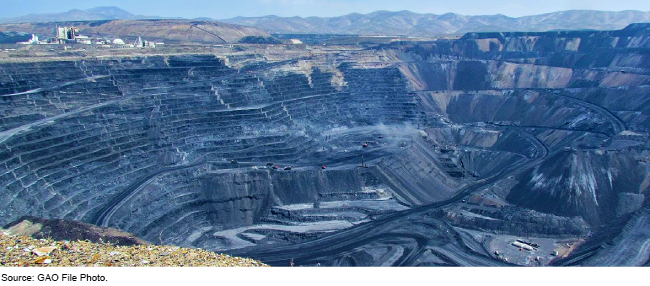Federal Land Management: Key Differences and Stakeholder Views of the Federal Systems Used to Manage Hardrock Mining
Fast Facts
Hardrock minerals, like gold and copper, are crucial for modern technology. But mining can create lasting health hazards and contamination.
This report describes, among other things, stakeholder views on management of hardrock mining on federal lands.
Industry stakeholders emphasized a need for certainty—in knowing, for example, that lands will be open for exploration and can be developed. Public interest and tribal stakeholders emphasized balanced land use that, for example, doesn't bar future uses other than mining.
Stakeholders saw room for improvement in environmental stewardship, governance and transparency, and administrative resources.
A gold mine in Nevada

Highlights
What GAO Found
Stakeholders GAO interviewed provided their views on the two systems used to manage hardrock mining on federal lands (see figure). Under the location system, the public generally has the right to explore federal lands, stake mining claims, hold the claims in perpetuity, and extract minerals without paying a federal royalty. Under the leasing system, the public generally must obtain agency approval to explore federal lands for minerals and must obtain a mining lease, which sets time limits and other conditions, including paying a federal royalty. GAO found collective differences between the views of different stakeholder groups. For example:
- Industry stakeholders' comments reflected a general emphasis on certainty: certainty that federal lands will be open and available for exploration, that they will be able to develop the deposits they find, and that they will have ample time to accommodate the lengthy mine development process. These are characteristics that these stakeholders generally described as advantages of the location system.
- Public interest and tribal government stakeholders' comments reflected a general emphasis on balance: that mining will be equitably balanced with other land uses, that the public will have the opportunity to participate in land- use decisions, and that mining will not preclude other future uses of the land. These are characteristics that these stakeholders generally described as advantages of the leasing system.
Number of Hardrock Mining Operations Authorized to Produce Minerals on Federal Lands by System and State, as of September 30, 2018

However, collective comments from stakeholders suggested that neither system wholly advances their goals in all respects and those stakeholders identified areas for improvement in the management of hardrock mining on federal lands. These areas fell in three broad categories:
- Environmental stewardship. For example, some stakeholders said abandoned mines pose various challenges and suggested establishing federal funding sources for reclamation.
- Administrative resources. For example, some stakeholders said greater agency staff expertise, as well as an appropriate level of staffing, could improve overall agency management of hardrock mining activity.
- Governance and transparency. For example, some stakeholders identified public engagement as an overall area for improvement and said steps should be taken to increase public access to information about mining activities.
Why GAO Did This Study
Hardrock minerals, such as gold and copper, are crucial resources for modern technology. However, mining by its nature can create lasting health hazards and environmental contamination.
The Department of the Interior's Bureau of Land Management and the Department of Agriculture's Forest Service are responsible for managing hardrock mining on the federal lands they manage. Federal management of hardrock mining has been a source of ongoing debate, in part because the agencies use two different systems, depending on where the resources occur:
- the location system under the General Mining Act of 1872 to manage hardrock mining on public domain lands (those usually never in state or private ownership), and
- the leasing system first adopted in the 1940s to manage hardrock mining on acquired lands (those granted or sold to the United States by a state or citizen).
GAO was asked to review hardrock mining on federal lands. This report describes, among other things, stakeholder views on the systems and areas for improvement.
GAO reviewed relevant laws, regulations, policies, and literature about mining systems. GAO interviewed agency officials. GAO interviewed stakeholders selected to reflect a broad range of perspectives from industry, public interest groups such as environmental organizations, and tribal governments.
For more information, contact Mark E. Gaffigan, (202) 512-3841 or gaffiganm@gao.gov.
